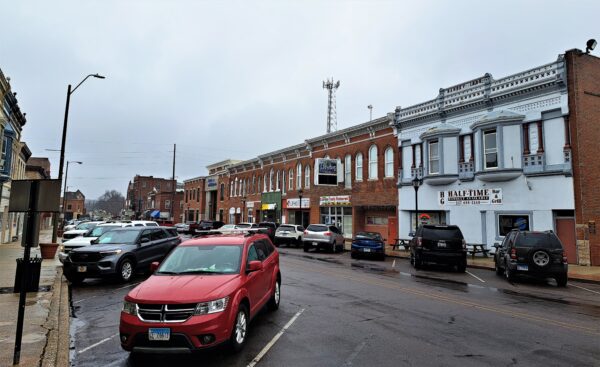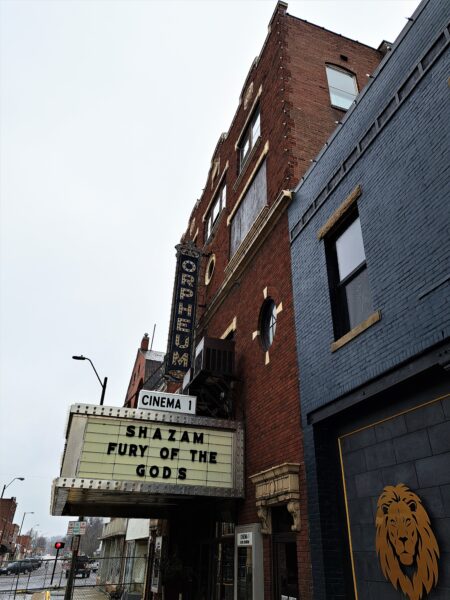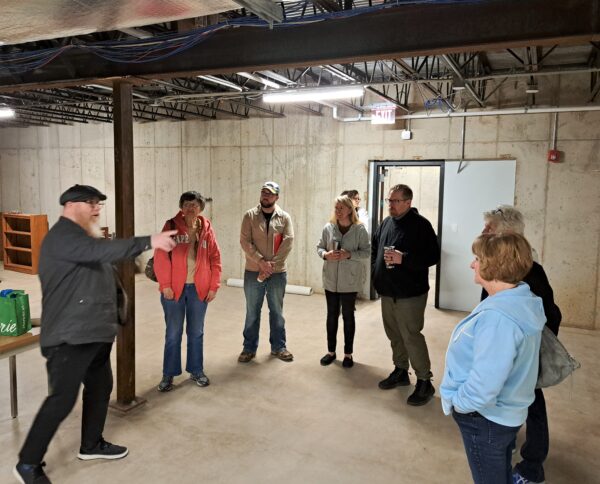How to invent a comeback…
The story of Hillsboro, Illinois is celebrated in a new exhibition, Spark! Places of Innovation, on display at Hillsboro Public Library for five weeks from July 29 to September 2. This exhibition, hosted by Imagine Hillsboro, is the latest from Museum on Main Street, a partnership between Illinois Humanities and the Smithsonian Institute that brings compelling traveling exhibitions to communities with populations fewer than 25,000 throughout Illinois.
When our friends at the Smithsonian learned Hillsboro’s history, they enthusiastically selected it as one of 30 small towns, including seven here in Illinois, to be profiled in Spark! as examples of communities that have fostered and harnessed innovation.

If an imaginary parachutist were to land in the heart of Hillsboro’s historic downtown on South Main, they might suppose that the number and variety of downtown businesses indicate a population of 12,000 to 15,000 residents. In reality, Hillsboro’s population is only 5,900 and is situated on Illinois highways 127 and 16, both two-lane roads. Judging by its sophisticated coffee shops, microbreweries, nifty renovated movie theater, and used record store, the parachutist might take another guess that Hillsboro must be a college town. Lincoln Land Community College, based in Springfield, offers classes in town, but no colleges have been located in Hillsboro since the 1850s.
Hillsboro’s economy precipitously diminished in the 1990s and early 2000s as coal mining declined and both a glass factory and a zinc processing plant closed in rapid succession. Local civic leaders recognized that, to sustain itself, the community would need to identify other economic pathways and pursue them vigorously. Fortunately, much of the infrastructure that had developed alongside the now-moribund industries—locally owned banks, a recently upgraded hospital, media outlets, grocery stores, the city and county governments—remained sound.
“The shutdown of the plants turned Hillsboro from a blue-collar to a white-collar town, interestingly. Our official numbers back that up,” observed Jonathan Weyer, who’s been involved in community and economic development in town since 2019. The economic pathways pursued by the community eventually led to a downtown revitalization trend that continues today.
“This town’s been getting rebuilt over the last decade or so, slowly,” observed Sarah McConnell, Hillsboro’s economic development and community planner. “These amazing community members who chose to make their life here decided that they didn’t want to live anywhere else, but they also didn’t want to live without the things they wanted. So, what do you do when you want something and no one else is doing it? You do it yourself. That’s how downtown has become what it is.”

“Young people started moving into town, or moving back into town, or are married to someone who’s from here, and started buying up buildings really cheap and just redoing them in their spare time,” Weyer explained. “And then about 2018, 2019, Black Rabbit (Coffee) came in, the brewery came in, and things just rolled out from there.”
A few residents occasionally wondered whether some of the new businesses might be too reflective of collegiate or suburban sensibilities to be suitable for Hillsboro, but they soon recognized the value of them and saw the potential for more. Weyer noted that they also recognized that “a lot of the stuff downtown is actually done by natives or people who’ve lived here most of their lives, so everybody in the community knows them.”
In 2014, Hillsboro undertook MAPPING the Future of Your Community, a participatory planning program facilitated by Western Illinois University’s Illinois Institute for Rural Affairs. The next year, the city council, including several newly elected members, implemented various initiatives to stimulate downtown development, including Tax Increment Financing (TIF) district and façade renovation grants. Soon afterward, Atlas 46, a civic-minded workwear manufacturer based in the St. Louis area, opened a plant in downtown Hillsboro, supplementing existing small manufacturers such as Hayes Abrasives. The Eisentraut family restored the circa-1920 Orpheum Theatre, often hosting creative, participatory community events in conjunction with movies. Downtown Hillsboro is now home to several creative-sector businesses, such as Heartland Gallery.
Jonathan Weyer remained Hillsboro’s development specialist through much of the pandemic—during which, remarkably, seven new businesses opened—before starting a new job with Atlas 46. Sarah McConnell succeeded him. Though she was raised in Teutopolis and lived in Shelbyville for most of her adulthood, she was familiar with Hillsboro, having visited family there often, and had recently moved here to open a restaurant with her husband.
According to McConnell, the community has developed a culture of welcoming experimentation and risk-taking in business development. “We’re not dream squashers,” she commented. “I think we’ve got enough success stories downtown now that we can say, ‘You could own your own business here.’”
That culture contributed to one of Hillsboro’s newest and most ambitious restorations, that of the Red Rooster Inn,established in 1902. Kendra and John Wright, who returned to the area after living in California (where John worked for Apple and was instrumental in the development of the iPhone), extensively renovated the building and reopened it in June.

Kendra serves on the city council, which has continued to prioritize economic development, collaborating with the county government and regional company CTI Fiber in 2018 to provide high-quality Internet access for the community. The composition of the council reflects Hillsboro’s success at retaining and attracting younger residents. “It’s three Gen Xers, one millennial, and one Gen Z,” Weyer remarked.
Sarah McConnell attributes that success not only to the community’s forward-looking spirit but also to its rootedness. “How do we get our kids to move home when they’re ready to settle down and start families? I think the keyword is ‘home.’ It has to feel like home,” she commented.
Hillsboro will celebrate its Bicentennial during Old Settlers’ Days next month. Old settlers, new settlers, and guests alike will learn about the community’s past from a companion exhibition produced by Imagine Hillsboro to accompany Spark!, showing how local newspapers have reported and interpreted pivotal events in Hillsboro’s history. It’s curated by accomplished writer Tori O’Dell of The Journal-News, itself profiled recently in Beacons in the Darkness: Hope and Transformation Among America’s Community Newspapers by Dave Hoekstra (Agate Publishing, 2022).
Hillsboro residents and visitors—and, subsequently, people throughout the United States—will further see the community’s present highlighted in Spark! Places of Innovation, on display through September 2. RSVP here to Imagine Hillsboro’s Spark! Launch Party on July 28.
About Illinois Humanities
Illinois Humanities, the Illinois affiliate of the National Endowment for the Humanities, is a statewide nonprofit organization that activates the humanities through free public programs, grants, and educational opportunities that foster reflection, spark conversation, build community and strengthen civic engagement. We provide free, high-quality humanities experiences throughout Illinois, particularly for communities of color, individuals living on low incomes, counties and towns in rural areas, small arts and cultural organizations, and communities highly impacted by mass incarceration. Founded in 1974, Illinois Humanities is supported by state, federal, and private funds.
Learn more at ilhumanities.org and on Facebook, Twitter, Instagram, and LinkedIn @ILHumanities.
Featured Image:The Hillsboro water tower features an image of a coal miner, reflecting a significant component of the community’s economic history.